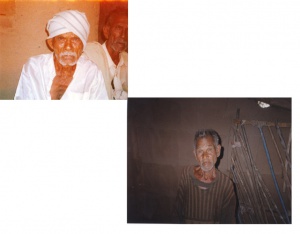Name : Shri Rupjibhai Kalubhai Vasava, Shri Kodarji Kaluji Pagi, Shri Mandaviyabhai Chandiyabhai Vasava
District & State : Bharuch, Gujarat
Category : Plant varieties
Award : Consolation
Award Function : 4th National Grassroots Innovation Awards
Award Year : 2007
Innovation Description
Use of ?Dhumas1 ?(Combretum ovalifolium) to control Blister beetle in maize crops.
Ninety-five year old Shri Rupjibhai Kalubhai is one of the oldest practitioners of this practice in the village and surrounding areas. Inspite of his age, he still maintains good health and is able to walk around freely, without any support. His family consists of his wife, three sons and their family. Two of his sons stay with him and have taken up farming as a profession, while the third one is staying in Ankleshwar and working with Gujarat Industrial Corporation on contract.Farmers of Valia taluka have been known to follow a unique method of pest control in maize crop. The attack of ?sunga? (local name of insect named blister bettle) is normally observed at the flowering stage, causing serious damage to the crop by sucking sap/juice from the pollen of maize flower. Infested pollens dry out and fail to fertilize ova and consequently, the yield gets considerably reduced.Farmers unanimously mention that Shri Rupjibhai is the oldest practitioner of the practice and all of them consult him, if there is an attack on their crops.In this process, five-six farmers stand equidistant in a row, in the direction of the wind, carrying leaves of ?Dhumas? in bags placed on their back. They start moving from one side of the field to the other in the direction of wind. While moving across the field, they catch a couple of ?sunga? from the air/plants and crush them by rubbing them between two-three leaves of dhumas held between the palms of hands. This results in emission of a peculiar smell from the ruptured mixture of leaves and insects, which repels the rest of insects. As soon as the effect of the smell gets reduced, fresh insects and leaves are crushed to replicate the treatment continuously.Alterations to the above practice were also found, after a detailed survey to find out more people practicing the method to control pest, in the surrounding villages. Shri Kodarjibhai Kalubhai Pagi (75) uses the leaves of a plant locally known as kamdo instead of dhumas for control of Khapedi (Brown hopper) and Kansia (Blister beetle). He is an agriculturist and grows wheat, pigeon pea, maize and bajara on the nine acres of land he owns.While, only the plant used is different the practice remains the same. He mentions that he learnt the practice from his father and has adopted it exactly in the same manner in which his father had trained him. Further, he added that as he and other villagers have been getting good results from the use, he is not willing to make changes in the practice.
Alterations in the practice: Use of Bangoliya3
Shri Mandaviyabhai Chandiyabhai (65) also has a similar practice to control bristle beetle in maize and bajara crop with some minor alterations. A marginal farmer and a herbal healer, he has two brothers and a son in his family. People from nearby villages come to him for treatment of various human and livestock diseases.The practice remains the same excepting the use of Bangoliya leaves crushed along with blister beetle to control infestation of the latter in maize and bajara. In this case, however, unlike Rupjibhai?s practice where five-six persons are involved, here it is claimed that only one person can easily cover field for executing this practice.
http://nif.org.in/innovation/Practices_to_control_Blister_beetle_in_maize_and_bajra_crops/367
